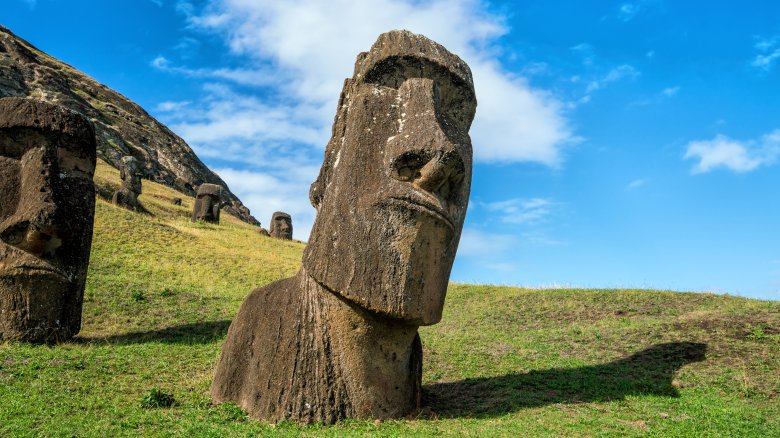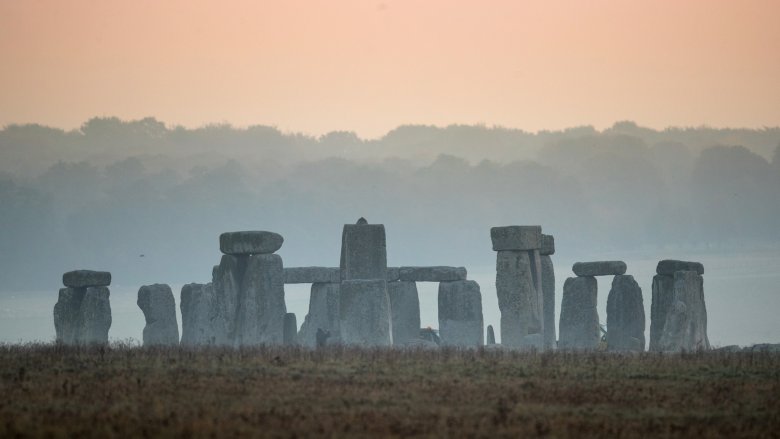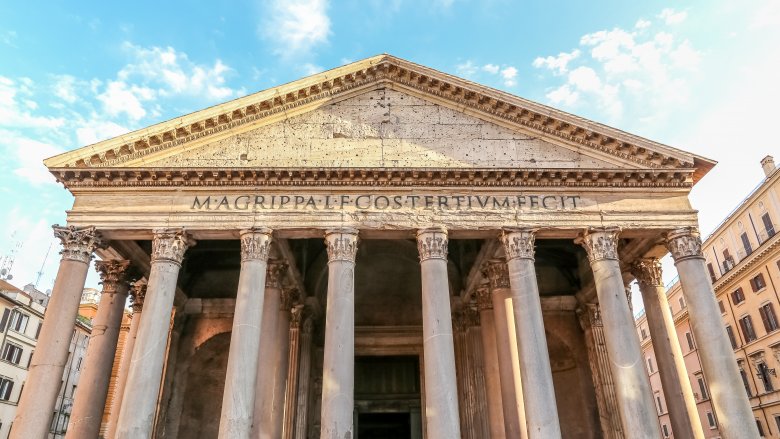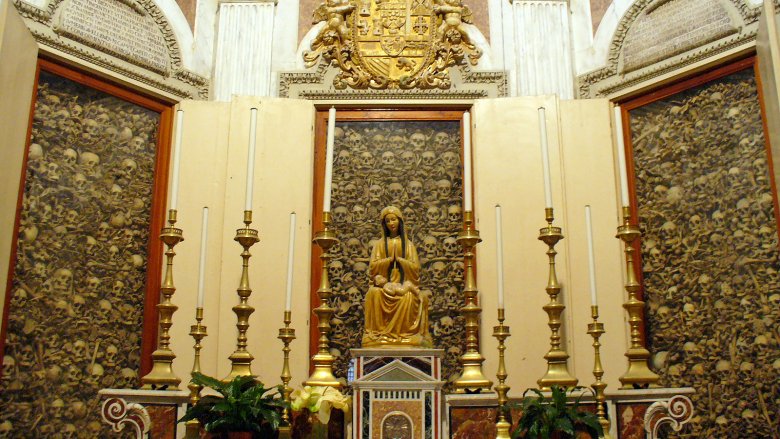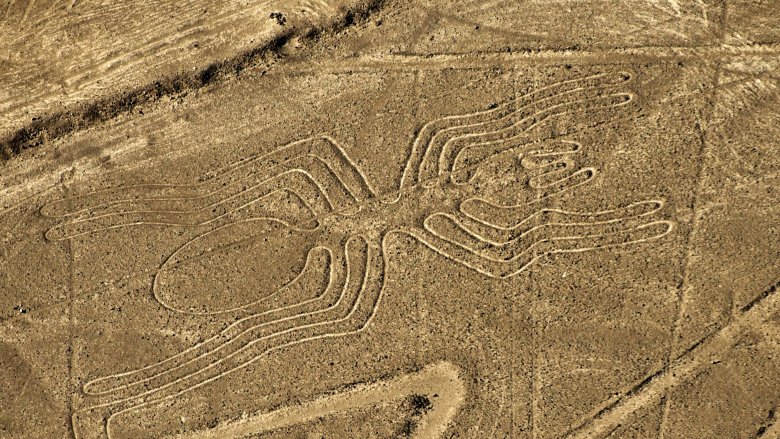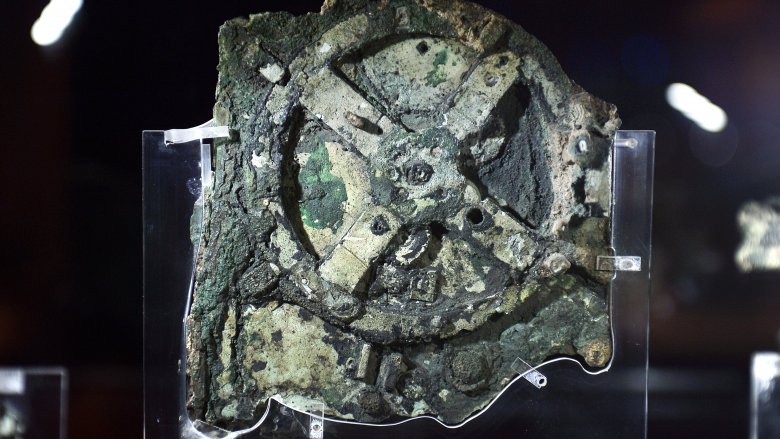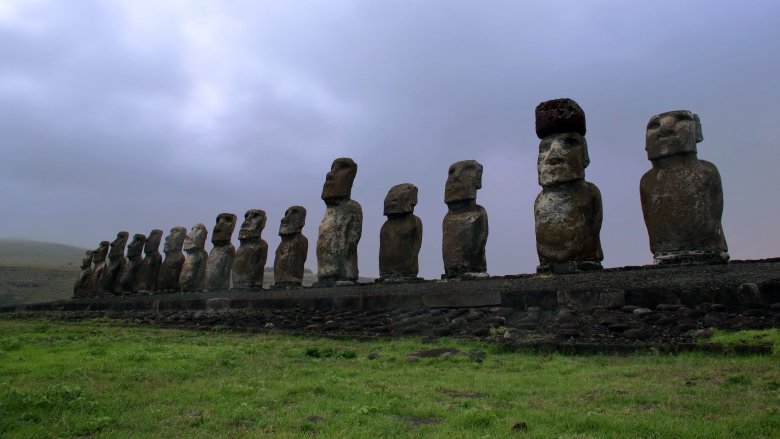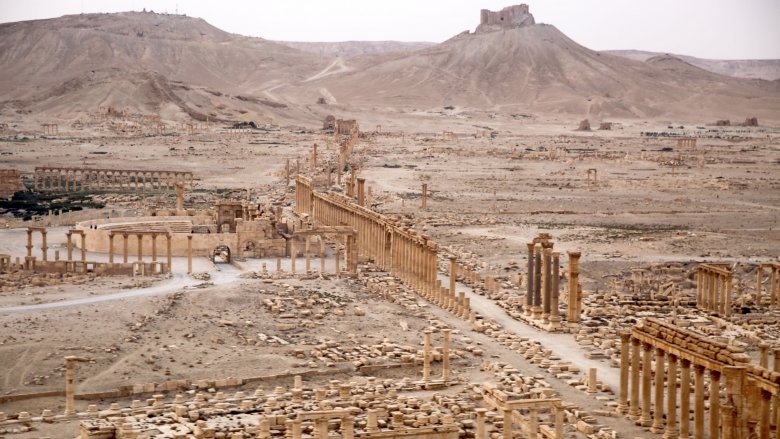Mysteries From The Ancient World That Have Been Solved
The worlds of the ancient Greeks, Romans, Egyptians, Celts, and other once-great civilizations are fascinating to modern minds in part because of the great things they accomplished without the aid of modern science and technology, but also in part because so much of their knowledge has been lost and the secrets of these cultures are alluring mysteries to us today. While the whys and hows of many of the world's most famous and beautiful ancient landmarks have eluded researchers of the past, advances in technology have meant that modern archaeologists, historians, and scholars have been able to uncover more about history's most tantalizing enigmas in recent years than ever before.
In the last decade alone, more has been unlocked about the secrets of the Romans, Persians, Greeks, Vikings, and others than would have been thought possible in previous years. Want to know more about what's hiding inside Stonehenge, the pyramids, a holey holy skull, the world's first computer, and more? Read on to discover the solutions to some of the ancient world's most perplexing mysteries.
Who put the stone in Stonehenge?
Stonehenge, the prehistoric ring of standing stones on England's Salisbury Plain, is one of the great mysteries of the ancient world, in part because the questions surrounding it hit on the classic "five W's and an H" line of questioning: Who built it? What does it mean? Where did these rocks come from? When was it built? Why did they do it in the first place? How did they get those giant rocks over there anyway? While some of these questions have been answered to a degree — it was probably built between 3000 and 2000 B.C., its purpose is likely astronomical in nature, and so on — there remain enough head scratchers about it that are deep enough that the itch can worm its way into your brain.
Fortunately for the sake of your itchy brain, as Smithsonian reports, researchers have made strides in answering at least one of those questions by uncovering evidence that at least some of the stones used to construct Stonehenge came from quarries in Wales, some 180 miles away from Salisbury. Apparently in these quarries, slabs of stone are already mostly vertically oriented, and so dragging these "ready-made" blocks out of the Welsh quarries for almost 200 miles was preferable to carving stones out of a more local source. In a sense, this almost raises more questions, but it seems that much of the beauty of Stonehenge comes from the fact that we'll never truly understand it. And that would be okay if our brains just weren't so darn itchy about it.
The volcano that changed Roman history (no, not that one)
The Romans used concrete extensively in their architecture during the classical era of the Roman republic all the way until the fall of the Western Empire. Its versatility and quick hardening led to what is known as the Roman architectural revolution, and the freedom from the shortcomings of rock and brick gave the Romans the ability to implement the arches, vaults, and domes that ancient Roman buildings are known for. Its relative strength is also the reason that so many classic Roman structures — the Pantheon, the Colosseum, the Baths of Caracalla, the Pont du Gard, and numerous bridges and aqueducts — have survived in part or in whole to the present day. Following the collapse of the Western Empire the technology of making concrete was lost until the mid-18th century. Modern concrete, however, differs in composition from Roman concrete, and for nearly 2,000 years it was a mystery how the Romans made the material that built an empire.
In 2015, though, as Gizmodo reports, a geophysicist at Stanford University named Tiziana Vanorio cracked the secret thanks to a catastrophe from her own youth, namely the eruption of the volcano Campi Flegrei that forced the evacuation of the Italian city Pozzuoli in 1982. While studying the caprock of this volcano and why it behaves the way it does, Vanorio discovered a concrete-like material that was practically identical to Roman concrete. The Romans, keen observers of the natural world, took inspiration from nature's own concrete to formulate a material that literally changed history.
Writing in Norse code
Runes, while often referred to in modern times in ways that make them sound esoteric and magical, were just letters in the alphabets used by different Germanic cultures to write their languages (including English, the least magical language) before they adopted the Latin alphabet following Christianization in the Middle Ages. Some runic inscriptions, however, are harder to interpret than others. It turns out that this is intentional: A number of the inscriptions are written in code, and one of these centuries-old Viking codes — known as jötunvillur — went undeciphered for years until a runologist from the University of Oslo named K. Jonas Nordby cracked the code in 2014.
As the Guardian reports, Nordby was able to figure out the secret thanks to the discovery of a low-key Rosetta Stone: a stick on which two people had written their names in both jötunvillur and standard runes. This allowed Nordby to realize the trick was that the standard runes would be replaced by the last letter in the name of the rune — for example, the rune maðr, which normally makes an "m" sound, would be replaced with the rune for "r," because maðr ends in "r." Such rune sticks would have been used to communicate, but the use of code, it seems, was less for privacy and more for the sake of a game that was meant to help teach runes or even just to show off, a tendency that has not at all declined in the intervening centuries.
Me want honeycomb
On August 14, 1480, Ottoman admiral Gedik Ahmed Pasha conquered the Italian city of Otranto following a 15-day siege. Men over the age of 50 were killed, and women and children were sold into slavery. The remaining 800-plus men of Otranto were given the chance to convert to Islam; refusing, each man was taken outside the city and beheaded. Known as the martyrs of Otranto, these nameless men were beatified in 1771 and canonized in 2013 as the patron saints of Otranto by Pope Francis. For hundreds of years, the skulls of these men have been displayed in large glass cabinets in the Cathedral of Otranto, all with their faces pointed toward the visitors. All, that is, except for the mysterious so-called honeycombed skull, which is arranged to display the pattern of 16 perfectly round holes in its cranium.
For centuries, there was mystery surrounding how and why this skull was perforated. As Gizmodo reports, however, researchers at the University of Pisa seem to have cracked it in 2015. The perfectly rounded conical holes told researchers that the culprit would have used a half-moon shaped trepan, which as everyone knows is a drill bit used specifically for drilling into the skull. But the how is perhaps not as interesting as why: The driller, who would have done the deed centuries after the skull's owner's death, was likely harvesting that good, good bone powder. In the late Middle Ages, powder made from the bones of saints or martyrs was believed to be particularly potent against paralysis, stroke, epilepsy, and other brain disorders.
It turns out trees are important
The Nazca people were an ancient civilization in what is now Peru, perhaps best known today for the mysterious Nazca lines, intricate and complex miles-long line drawings of subjects such as a hummingbird, a jaguar, trees, flowers, and a monkey. These drawings were made by cutting shallow incisions into the soil of the Nazca Desert, about 250 miles south of Lima, and many are so big they can only be fully viewed from the air. The Nazca people made these geoglyphs some time between 500 B.C. and 500 A.D. and were in many other ways a sophisticated and advanced society as well, including developing an intricate system for irrigating their crops. However, despite all the complexity and sophistication of the Nazca society, this entire civilization vanished about 1,500 years ago, and for years, no one could explain why.
In 2009, as the BBC reports, researchers were able to finally provide some insight into the disappearance of this once formidable culture by studying the soil record. It seems deforestation was at the heart of it: The Nazca cut down too many huarango trees to plant maize, not knowing that huarango trees were basically the only thing holding the ecosystem together. Without this keystone plant in place, the area basically became a desert and the Nazca were swept away by El Nino-related floods. It almost seems like there might be a lesson for modern society to take away from the destruction of a once-flourishing society through their own hubris and negligence, but ... nah, probably not.
Ancient Greece's space computer
In 1901, divers off the coast of the Greek island of Antikythera were exploring a Roman-era shipwreck when they discovered, among other treasures, a lump that proved to be the remains of a smallish wooden box. By 1902, an archaeologist was able to reveal that the box contained a gear, but by and large the artifact stumped scholars. In the 1970s and 1990s, advances in X-ray technology allowed researchers to determine that the device was likely designed to replicate the motion of the heavenly bodies — Sun, Moon, and planets. Beyond this, however, the secrets of the green-encrusted bronze cogs were too hard to unlock and failed to spark the imaginations of anyone besides ancient aliens types.
That is, until about 2006, when modern technology such as CT scans employed by researchers at Cardiff University in Wales revealed more of the inner workings of the Antikythera mechanism, including previously hidden inscriptions. As Smithsonian explains, we now know that the Antikythera mechanism was basically an ancient analog computer, using a series of over 30 interlocking bronze gears to follow the movements of the Sun and Moon through the zodiac, to predict eclipses, to model the irregular orbit of the Moon, and even serve as a calendar to track regular events, such as the four-year cycle of athletic games. This fascinating device helps give us a better grasp of the ancient Greeks' understanding of the universe; namely that it follows a set of predefined rules, like a clock, a view that we moderns have arrogantly fooled ourselves into thinking was a discovery of our own.
A lost army found
Cambyses II was the son of Cyrus the Great and was the ruler of the Persian Empire from 530 B.C. until he died in 522. According to the Greek historian Herodotus, writing about a century later, Cambyses became enraged when the priests at the Temple of Amun refused to acknowledge the legitimacy of Persian control over Egypt, and so he sent 50,000 soldiers from the city of Thebes to attack the Oasis of Siwa and destroy the oracle there. As the story goes, the army wandered for seven days in the desert, stopped at an oasis, and then disappeared among what Herodotus calls "vast columns of whirling sand." That said, in addition to being called the Father of History, Herodotus is also known as the Father of Lies, and archaeological evidence of his reports about the Persian Wars could charitably called "rare."
According to NBC News, however, Italian researchers felt very confident in having found the remains of the lost army of Cambyses in 2009. Twin archaeologists Angelo and Alfredo Castiglioni, searching the sands in the region of the Oasis of Siwa, uncovered a rock that could have served as a natural shelter in a sandstorm. In this area they soon uncovered numerous artifacts including bronze daggers, arrowheads, a silver bracelet, and an earring that are all consistent with items from the Persian Empire. Oh yeah — and they also found a mass grave packed with hundreds and hundreds of human bones, with more Persian artifacts surrounding them. Looks like we can score this one in Herodotus' favor.
Keep your head in the game
Rapa Nui, the remote Pacific island far off the coast of Chile (of which it is now designated a special territory), is better known to English speakers as Easter Island and is home to numerous structures that have fostered mystery, curiosity, and fascination since Europeans first landed on the island in the 18th century. While Easter Island is home to numerous stone works, including platforms called ahu, walls, houses, and petroglyphs, it is most famous worldwide for its mysterious enormous monolithic statues called moai, perhaps better known as the "Easter Island heads." There are a number of questions about these heads — which, notably, are not actually heads, as most have torsos or even full bodies that have been covered in part or in whole by shifting soil — such as how the huge stones were transported from the quarries, what their purpose was, and why they were placed where they were. But they're difficult questions to answer due to the decimation of the native population by Europeans through slavery, abduction, and the introduction of smallpox.
One of those questions seems to have been answered, however. Researchers at Binghamton University in New York used quantitative spatial modeling to try to find a provable relationship between the positioning of the statues and natural resources on the island. Their models found that the location of the statues was "tightly linked" with access to freshwater sources. The more water, the more statues; no water, no statues. The pattern proved to be consistent, so it seems for now that at least one mystery of Easter Island has been resolved — something to do with water!
How do you solve a problem like Palmyra?
The ancient city of Palmyra, now part of Syria, was once one of the wealthiest and most important cities of the Roman Empire. It was the key location connecting the trade routes of the Western and Eastern halves of the empire, which brought it great wealth and the privilege of internal autonomy within the empire. Its great wealth and relatively large population (about 100,000 during the early empire) meant it was able to fill the city with monumental public works, such as its Great Colonnade, the Temple of Bel, and numerous tower-shaped tombs. All of this is well and good, but it raises questions for modern observers: Namely, why would you put such an important city in the middle of a desert? How did they, you know, eat?
Thanks to the combined efforts of researchers from Norway and Syria, we now know that at the time, Palmyra wasn't a desert per se; it was more of an "arid steppe." Archaeological methods uncovered hidden water reservoirs that the inhabitants of the city — as well as a number of lost villages in the area — would have filled with rainwater that collected into small creeks and rivers now known as wadi. Using dams and cisterns allowed the Palmyrans to water crops to feed themselves and the surrounding area. Additionally, Palmyra's relatively dangerous location also meant they were able to increase their wealth by offering protection to travelers and merchants as they crossed from West to East and vice versa.
Ramping things up
The Pyramids of Giza are the only remaining structures among the Seven Wonders of the Ancient World, and they have remained a constant object of fascination for the over 4,500 years of their existence. Besides being an incredibly popular tourist destination, they have been a subject of research and study for many years, and yet they manage to both confound and surprise researchers even now. Many questions about their construction have been asked, such as how they are so perfectly aligned, and just how the many enormous blocks used in their construction were transported from quarries and raised into their positions within the pyramids themselves.
Well, at least one portion of the mystery seems to have been solved, thanks to discoveries by archaeologists in 2018 near the city of Minya. According to Lonely Planet, archaeologists working in the quarries at the Hatnub site uncovered a system of ramps that would have made it possible for ancient workers to raise up the enormous limestone blocks used to construct the pyramids. The structure contained a large central ramp with carved staircases running along each side that would have made it possible for multiple people to drag the blocks up and out. This ramp system on its own would not be enough to show that this structure was used in the development of the pyramids, but helpfully, some inscriptions were also uncovered dating this system to the time of the Pharaoh Khufu, who built the pyramids, which is a pretty good sign in favor of these being pyramid ramps and not just used for sicknasty skate tricks.
